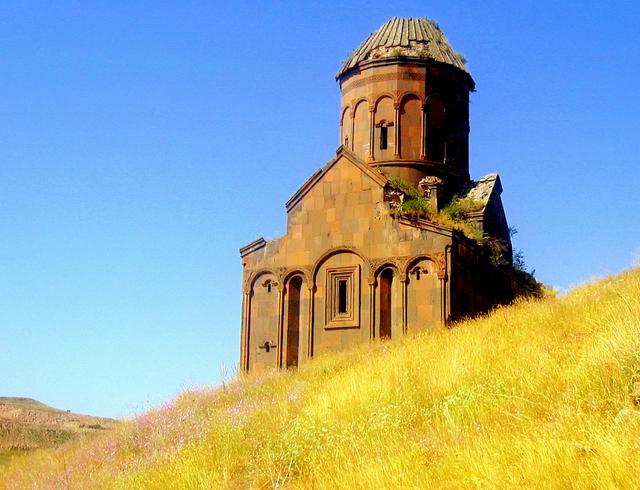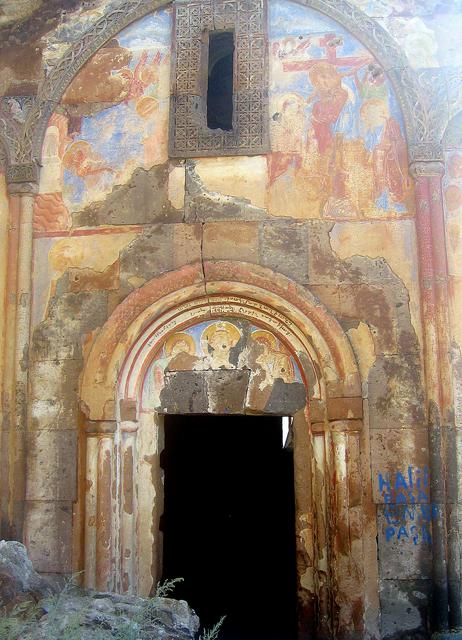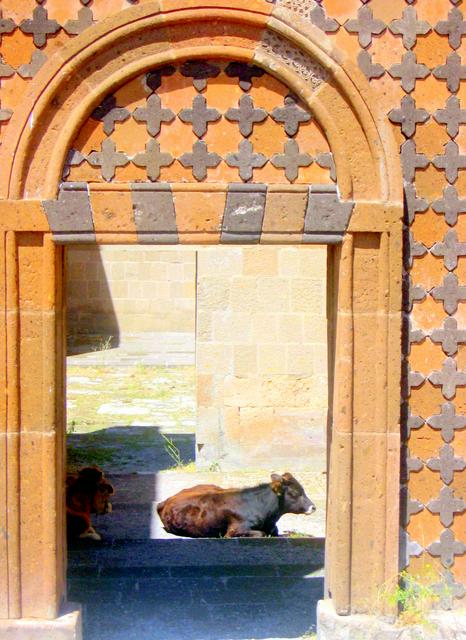
Once upon a time, Ani, the capital of the Armenian Empire under the Bagratid Dynasty, rivaled the Middle East's most powerful cities. Now, the city exudes the eerie ambiance of a ghost town surrounded by the remote landscape of the rolling Turkish steppe, the heavy weight of tragic history, and a nearby contested border; it has been made a UNESCO World Heritage site. Try to visit in June, if possible, because this is when the vast, flat plains are teeming with wildflowers.
Ani is a truly unique, must-see destination for any traveller to the Turkish East.
Ani's first rise to prominence was in the 400s AD. At this time, it was a hilltop fortress that belonged to the Armenian Kamsarakan Dynasty; by the 800s, however, the Kamsarakan possessions in Eastern Anatolia had merged with the Bagratid Dynasty. In 956, King Ashot III moved the Armenian capital to Ani, and Armenian Catholics followed. Consequently, the city became the undisputed center of Armenia, and it grew rapidly until, by the eleventh century, there were more than 100,000 citizens. At its height, the city became known as the City of Forty Gates and the City of a Thousand Churches.
However, following the death of King Gagik in 1020, Armenian power was split between two sons and the golden age ended. The son who controlled Ani, attempting to prevent invasion, named the Byzantine Emperor his heir; eventually, though, the Byzantine Emperor stated his claim upon the city. The new king of Ani tried to keep his city independent, but after three years of military defeats and a pro-Byzantine uprising, Ani surrendered and the Byzantines established control.
The Byzantines, however, had wasted their time and effort, as in 1064 the Seljuk Turks took the city and massacred the populace. The city of Ani survived for another 650 years, but it was now a provincial town at the edge of competing empires. The Seljuk Turks passed possession of the city to Kurdish Shaddadids; they were attacked repeatedly by the neighboring Georgian Empire at the behest of Ani's unruly Christian population. The Shaddadids were conquered in 1199 by Queen Tamar of Georgia, and the Zakarid Dynasty of Ani was established. The city prospered once again, but was devasted this time in 1236 by the invading Mongol Hordes. The Zakarids continued to govern the city as the vassals of various Turkic and Persian Empires, culminating with the Ottomans, but Ani gradually faded into uninhabited ruins.
In the late 1800s, the Russian Empire took control of the Kars and surrounding areas. The Saint Petersburg Academy of Sciences oversaw a large archaeological and restorative effort until 1917, when the Russian Revolution took place. Russian scientists succeeded in setting up a huge museum on-site, principally in the Minuchihr Mosque.
After the Russian Revolution and the founding of the Republic of Armenia, the Ottoman military drove east into former Russian territories with the intention of seizing the region and cleansing it of ethnic Armenians. The Russian-led archaeologists did what they could to salvage remains of the ancient city and fled to modern-day Armenia. During the Turkish War of Independence, the Grand National Assembly of Turkey ordered the Eastern Front commander that the "monument of Ani be wiped off the face of the earth." The commander did not obey, fortunately, so the monuments of Ani remain. On the other hand, however, Russian excavations and repairs were undone, and the site languished under what can be most favorably described as neglect.
Unfortunately, since the Ottomans seized Kars Province, Ani has been on the edge of one of the most hostile borders in the world: Turkey and the Soviet Union (and more recently Armenia). Ani has been within a Turkish military zone that precluded tourism. However, things have cooled down between Turkey and Armenia in more recent times, and militant Turkish opposition to acknowledging the ruins as a major tourist point of interest has subsided. There is a sign outside the main city gate that lists all of the approximately fifteen empires that have controlled the region; however, it does not mention the Armenians who built the city and are at the center of its history. The border remains tense and is visible from the ruins, but anyone can visit Ani without any sort of permit, and photography restrictions are a thing of the past. Although the Turkish government makes friendly noises about preservation, restoration, and excavation, it still receives low marks from international NGOs.
 Pinkish stone ruins of Armenian cathedrals, churches, homes, fortresses, and palaces float eerily across the desolate grassy landscape. Most of the well preserved Armenian churches date from the late tenth century to early eleventh century. The most distinctive is perhaps the church of Christ the Redeemer, split perfectly in half by lightning, but still standing. Additionally there are smaller structures, which were once homes, the remains of the cities castle walls, and a fortress overlooking the ruins. Other sites include the (relatively hard to find) ruins of a Zoroastrian fire temple and a small Ottoman fort. From the area near the fort, look carefully across the ravine to see a collection of Karst caves that once served as home to troglodytic Anatolians.
Pinkish stone ruins of Armenian cathedrals, churches, homes, fortresses, and palaces float eerily across the desolate grassy landscape. Most of the well preserved Armenian churches date from the late tenth century to early eleventh century. The most distinctive is perhaps the church of Christ the Redeemer, split perfectly in half by lightning, but still standing. Additionally there are smaller structures, which were once homes, the remains of the cities castle walls, and a fortress overlooking the ruins. Other sites include the (relatively hard to find) ruins of a Zoroastrian fire temple and a small Ottoman fort. From the area near the fort, look carefully across the ravine to see a collection of Karst caves that once served as home to troglodytic Anatolians.
- Ani Cathedral.
- Citadel.
- City walls.
- Church of Ashot.
- Church of Bagarat-Arkaun.
- Church of the Holy Apostles.
- Church of the Holy Redeemer.
- Church of Saint Elia.
- Church of Saint Gregory of the Abughamrents.
- Church of Saint Gregory of Tigran Honents.
- Georgian Church.
- Karst Cave Village.
- King Gagik's Church of Saint Gregory.
- Mosque of Minuchir.
- Virgins' Chapel.
- Silk Road Bridge.
- Monastery of the Virgins.
Ani Cathedral.
Citadel.
City walls.
Church of Ashot.
Church of Bagarat-Arkaun.
Church of the Holy Apostles.
Church of the Holy Redeemer.
Church of Saint Elia.
Church of Saint Gregory of the Abughamrents.
Church of Saint Gregory of Tigran Honents.
Georgian Church.
Karst Cave Village.
King Gagik's Church of Saint Gregory.
Mosque of Minuchir.
Virgins' Chapel.
Silk Road Bridge.
Monastery of the Virgins.
In 2016, the fortress was closed to tourists. However, if the fortress is open, it is worth scrambling up the rocky path for excellent views of Ani, the river gorge, and the steppe rolling towards Armenia's mountains.
There are limited choices so one is best to bring their own snacks and drinks. The Ani Cafe & Restaurant is a new eatery with clean western style bathroom facilities. There is also a little general store close to the main gates into Ani. There is a teahouse in the small village outside Ani, but absolutely do not forget to bring bottled water on a trip to Ani. The climate is very arid and seeing all the sites here will take a good deal of time; you will get badly dehydrated if you don't bring some water along. In winter, everything is closed, so be sure to bring food and water. There is a public toilet on the left of the main entrance.
